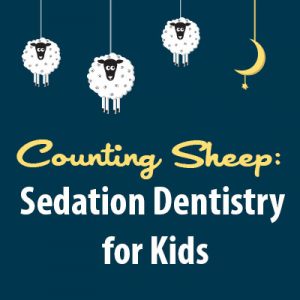Counting Sheep: Sedation Dentistry for Kids
Posted on June 13th, 2018
 Is Sedation Safe for Kids?
Is Sedation Safe for Kids?
Sedation dentistry for clients of all ages has steadily gained popularity in recent years due to its effectiveness reducing anxiety during dental treatments.
Children’s dentists—who train for two or three additional years to learn safe sedation techniques—may suggest sedation for children who have difficulty staying still, elevated stress levels, strong gag reflexes, or a physical disability that prevents them from getting the care they need.
Sedation dentistry may alleviate general agitation while enhancing feelings of contentment, which is particularly helpful during treatment of special needs pediatric patients. Sedation can also allow for the completion of extensive dental work using less time and fewer appointments.
If sedation could help take the fear and the tears out of your child’s dental appointments, it might be worth looking into!
Types of Sedation
There is more than one type of sedation dentistry. Conscious sedation is the most commonly used type for pediatric patients, as it allows them to remain alert enough to respond to verbal and physical cues.
There are several ways to administer conscious sedation depending on your little one’s needs. Nitrous oxide is the mildest form of sedation and they will breathe through a small face mask—they might even get the giggles.
Oral conscious sedation is mild to moderate with a heavier sedative effect than nitrous oxide. With oral conscious sedation, they will take a sedative about an hour before the appointment. Then there’s IV sedation which is the heaviest and is administered intravenously. IV sedation is typically reserved for children with severe anxiety or disabilities, or for more extensive dental treatments.
Children usually resume life as their active selves within six hours of conscious sedation depending on how it was administered. General anesthesia, on the other hand, is the complete loss of consciousness. If a child is under two years of age, the American Academy of Pediatric Dentistry recommends general anesthesia only be used in a hospital setting with medical support teams standing by in case of emergency.
It is commonly recommended that parents exercise extreme caution when considering any type of sedation for a child under three years old. It should also be noted that pain and physical discomfort are not affected by sedation medicines, conscious or otherwise. Pain medications (anesthesia) are given separately, customarily by injection which can be accompanied by topical numbing gel to take the prick out of the equation.
Consult your Pleasant Hill dentists, Dr. Chad Johnson, at Veranda Dentistry with your concerns and questions before choosing sedation dentistry for your child. We would be more than happy to discuss your options for helping them get the care they need without the fear and tears. Contact us today to schedule!
Sources
http://www.chp.edu/our-services/dental-services/patient-procedures/sedation
http://www.deardoctor.com/inside-the-magazine/issue-26/sedation-dentistry-for-kids/
https://www.nytimes.com/2017/08/24/well/family/should-kids-be-sedated-for-dental-work.html


